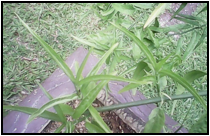Belalai Gajah
| Belalai Gajah | |
| Scientific Name | Clinacanthus nutans (Burm.f.) Lindau |
| Synonyms | Clinacanthus burmanni Nees, Justicia fulgida Burm, Justicia nutans Burm.f |
| Family | Acanthaceae |
| Order | Lamiales |
 |
{slider=Common Name}
Sabah Snake Grass, Gendis,Shen Cao, Phaya plongtong.
{/slider}
{slider=Description}
Annual shrub. Woody stems, jointed, upright, and green. Petiole 0.3-2 cm, sulcate, bifariously pubescent. Single leaf, shape lanceolate-ovate, lanceolate or linear-lanceolate, reinforced pinnate, 8-12 mm long, 4-6 mm wide. Compound interest, panicle shape, in the armpit leaves and at the end of the rod, the crown of the tube-shaped flowers, 2-3 cm long, pink. Corolla dull red with a green base, 3-4.2 cm, Calyx 0.9-1.3 cm; lobes linear, outside gland-tipped pilose, apex acute. Stamens exserted from mouth of corolla; filaments 1-1.5 cm, glabrous. Fruit box, round brown elongated.{/slider}
{slider= Chemical Constituents}
Composition: C. nutans composed of stigma sterol, lupeol, B-sitosterol (Dampawan, et al., 1976), five sulfur containing glycosides (Teshima, et al., 1997), two glycoglycerolipids (Satakhun, et al., 2001), six know C-glycosyl flavones (Teshima, et al., 1998), a mixtureof 9 cerebroside and a monoacylmonogalatosylglycerol (Tuntiwachwuttikul, et al., 2004).
Eight chlorophyll derivatives compounds with structures related to chlorophyll a and b were isolated from the chloroform extract by means of chromatographic techniques and bioactivity-guided fractionation to give eight pure compounds namely 13(2)-hydroxy-(13(2)-R)-phaeophytin b (1) 13(2)-hydroxy-(13(2)-S)-phaeophytin a (2), 13(2)-hydroxy-(13(2)-R)-phaeophytin a (3), 13(2)-hydroxy-(13(2)-S)-chlorophyll b (4), 13(2)-hydroxy-(13(2)-R)-chlorophyll b (5), 13(2)-hydroxy-(13(2)S)-phaeophytin b (6), purpurin 18 phytyl ester and phaeophorbide a (8), (Santi etal., 2006). These compounds, were shown to have anti-herpes simplex activity. Their inhibitory activity affected the virus before viral entry to the host cells.
(Santi, et al., 2006)
{/slider}
{slider=Geographical Distribution}
Wild distribution: South China, South East Asia - Myanmar, Thailand, Vietnam, Malaysia, Indonesia.
{/slider}
{slider=General Appearences}
It is an often cultivated small shrub approximately growing up to 0.5 to 3 m (1.6 to 9.8 ft) in height.
{/slider}
{slider=Plant Material of Interest}
This species has attracted public interest recently due to its high medicinal values for the treatment of cancer, inflammation and various skin problems. The plant is commonly used in the folk medicine of S China and SE Asia, being harvested from the wild for this purpose.In Java and Malacca, it is also sometimes cultivated as a hedge plant . The young leaves are eaten as a vegetable.
{/slider}
{slider=Traditional Uses}
The whole plant is used medicinally to regulate menstrual function; reduce swelling; remove blood clots; relieve pain; to set a broken bone; treat injuries from falls, fractures, contusion and strains; anaemia, jaundice and rheumatism , The plant is used in the treatment of eye diseases. Fresh leaves have long been traditionally used in Thailand as an anti-inflammatory drug to treat insect and snake bite, skin rashes, allergic responses, herpes simple virus(HSV) and varicella-zoster virus (VZV) lesions, (Santi, et al., 2006).
{/slider}
{slider=Pharmacology}
Anti- inflammatory and analgesic activities:
Extracts from the leaves were reported to possess analgesic and anti-inflammatory activities (Satayavivad, et al., 1996). Clinical trials have shown the successful use of a C. nutans cream/lotion for the relief of minor skin infammation, insect bite, treatment of genital herpes and varicella-zoster lesions (Charuwichitratana et al., 1999).
Anti cancer activity:
Antioxidant properties of C. nutans (CN) were evaluated using DPPH, galvinoxyl, nitric oxide, and hydrogen peroxide based radical scavenging assays. The result showed that chloroform extract of CN was a good antioxidant against DPPH and galvinoxyl radicals, but less effective in negating nitric oxide and hydrogen peroxide radicals. Antiproliferative effect of CN on several cancer cell lines was tested using MTT assay. Chloroform extract exerted the highest antiproliferative effect on K-562 (91.28 ± 0.03%) and Raji cell lines (88.97 ± 1.07%) at 100 μ g/ml and the other five cancer cell lines in a concentration-dependent manner. From this study, suggesting that CN extracts possess antioxidant and antiproliferative properties against cultured cancer cell. (Yong et al., 2013)
{/slider}
{slider=Toxicity Studies}
The acute oral toxicity study of methanol leaves extract of Clinacanthus nutans (Burm.f.) Lindau. was aimed to determine the oral LD50 value and identify the targeted organs in mice.The study was conducted by using male Swiss albino mice weighing 25-35 g. First group was served as control group while second and third group were orally treated with single daily dose of 0.9 g/kg and 1.8 g/kg of methanol leaves extract of C. nutans, respectively. All the animals were closely observed for 14 days. From the results obtained, No mortality was observed in both treatment groups. Weight for each mouse and relative organ weight (liver, kidney, spleen, lung and heart) showed insignificant difference when compared to the control group. In conclusion, acute exposure of 1.8 g/kg of C. nutans was safe in male mice without causing any adverse effects or mortality. The oral LD50 of methanol leaves extract of C. nutans was suggested to be greater than 1.8 g/kg bw in male mice. The conclusion is, CN did not produce any signs of toxicity in the animals. (Xiu et al., 2012)
{/slider}
{slider=Reference}
- Santi Sakdarat, Aussavashai Shuyprom, Thaweephol DechatiwongseNa Ayudhya, PeterG. Waterman, Gloria Karagianis: Thai Journal of Phytopharmacy Vol. 13(2) Dec. 2006 – 15(1) Jun. 2008
- Yong YK, Tan JJ, Teh SS, Mah SH, Ee GC, Chiong HS, Ahmad Z.; Clinacanthus nutans Extracts Are Antioxidant with Antiproliferative Effect on Cultured Human Cancer Cell Lines (2013)
- Charuwichitratana, S., et al. Hrerpes zoster: Treatment with Clinacanthus nutans cream. International Journal of Dermatology 35, no.9 (1996): 665-66
- Xiu Wen P'ng; Akowuah, Gabriel Akyirem; Jin Han Chin: Acute Oral Toxicity Study of Clinacanthus nutans in mice. International Journal of Pharmaceutical Sciences & Research;Nov2012, Vol. 3 Issue 11, p4202
- Satayavivad J, Bunyaoraphatsara N, Kitisiripornkul S, Tanasomwang W. Analgesic and anti-inflammatory activities of extract of Clinacanthus nutans Lindau. Thai J Phytopharm 1996;3:7-17.
{/slider}
- Last updated on .
- Hits: 6492
